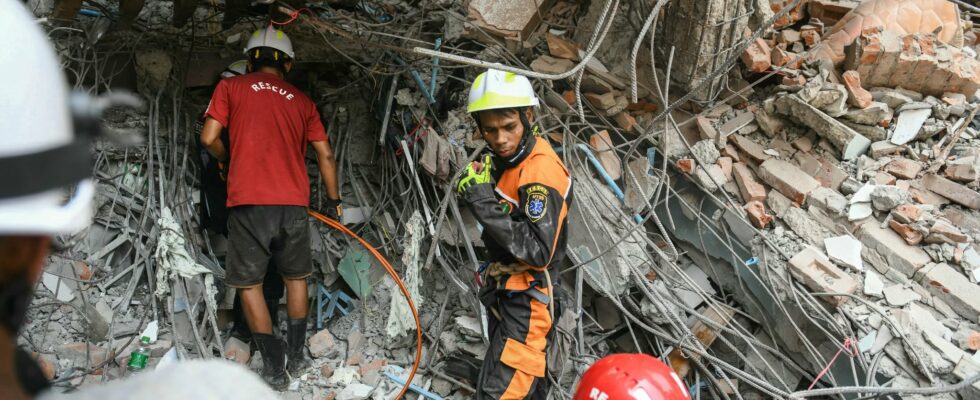The provisional assessment is dramatic. In Burma, the violent earthquake that struck Burma Friday March 28 left at least 1,700 dead, 3,400 injured and 300 missing. He also started Thailand. Two days after this earthquake of magnitude 7.7, followed a few minutes later by a jolt of magnitude 6.7, the emergency services try this Sunday to search for survivors and to help the victims despite a shortage of medical equipment. Burmese authorities have declared the state of emergency in the six most affected regions.
Popular Defense Forces (FDP), Burmese rebels, have decreed a two-week partial cease-fire from this Sunday, to facilitate rescue operations. The group will not attack the army – but will defend itself if necessary -, and assured that it would “collaborate with the UN and the NGOs to ensure the safety, transport and establishment of temporary emergency and medical camps” in the areas it controls.
International aid is organized in parallel. The World Health Organization (WHO) has announced that it has triggered its emergency management system and the mobilization of its logistics center in Dubai to prepare supplies for the injured. She urgently sent nearly three tonnes of medical supplies, including trauma kits and tents, from the Economic Capital Rangoon to Mandalay hospitals, the second city in Burma, close to the epicenter, and Naycyidaw where thousands of wounded are taken care of.
China, South Korea …
The chief of the junta, Min Aung Hlaing, launched an appeal for international aid, inviting “any country, any organization” to help. In the past, the military was reluctant to request such support from abroad in the event of a natural disaster. Pays in the region have responded to the appeal to rescue launched by the head of the Burmese junta. China sent a team of 82 rescuers to Burma on Saturday, as well as another team in Rangoon. Beijing will also provide emergency aid of 100 million yuan (12.7 million euros), the Chinese International Aid Agency announced. Thailand has declared this Sunday to have sent 55 soldiers and six rescue dogs to its neighbor Burma, as well as equipment, including cranes and excavators.
South Korea has promised two million dollars in humanitarian aid to “support rescue and rescue efforts” and do not exclude additional aid if the situation was to worsen. Hong Kong dispatched a team of 51 people, boarding 9 tonnes of equipment, including life detectors and two rescue dogs, and released an envelope of $ 30 million in Hong Kong ($ 3.5 million).
India has sent research and rescue teams, medical teams and a country hospital, aboard several military aircraft. Two navy ships carrying more equipment and rescue staff also set sail for Rangoon from Port Blair, in the Indian Islands of Andaman, facing Burma.
A Philippine team of 114 people, including doctors, firefighters and members of the armed forces, should leave on Tuesday for Burma. Vietnam, on Sunday, announced the deployment the same day of 79 rescuers on Sunday to help research and rescue operations. Malaysia will send around fifty rescuers “to support humanitarian and rescue operations in progress”. The Association of Nations of Southeast Asia (ASEAN), of which Burma and Thailand are members, “is ready to help” the two countries, added the Malaysian Ministry of Foreign Affairs.
A “serious shortage” of medical supplies
New Zealand will give $ 1.1 million, through the International Committee of the Red Cross. “This is a real disaster, and we are going to help,” American president Donald Trump told the press on Friday. For its part, Iran, through the voice of its Ministry of Foreign Affairs, said it was ready to contribute to humanitarian effort and rescue and rescue operations.
The United Kingdom has promised 10 million pounds sterling (12 million euros) in order to “increase the aid in the hardest areas affected by the earthquake and finance the supply of food and water, drugs and shelters”.
The European Union has released 2.5 million euros in initial emergency aid and indicated that it would assess the needs in the field before mobilizing more means. Ireland will unlock humanitarian aid of 6 million euros, which will be distributed via the Red Cross and the United Nations, its head of diplomacy Simon Harris announced on Saturday.
International agencies have warned that Burma could not afford a disaster of this size. Before the earthquake, the United Nations estimated that 15 million Burmese, or about a third of the population, would be affected by the risk of famine in 2025. A “serious shortage” of medical supplies weakens the assistance deployed on the spot, warned on Saturday the UN, stressing that the rescuers lacked in particular of “kits of trauma”, pockets of blood, essential drugs. Rescue operations are also complicated by the damage suffered by hospitals and other health infrastructure, as well as by roads and communication networks.
